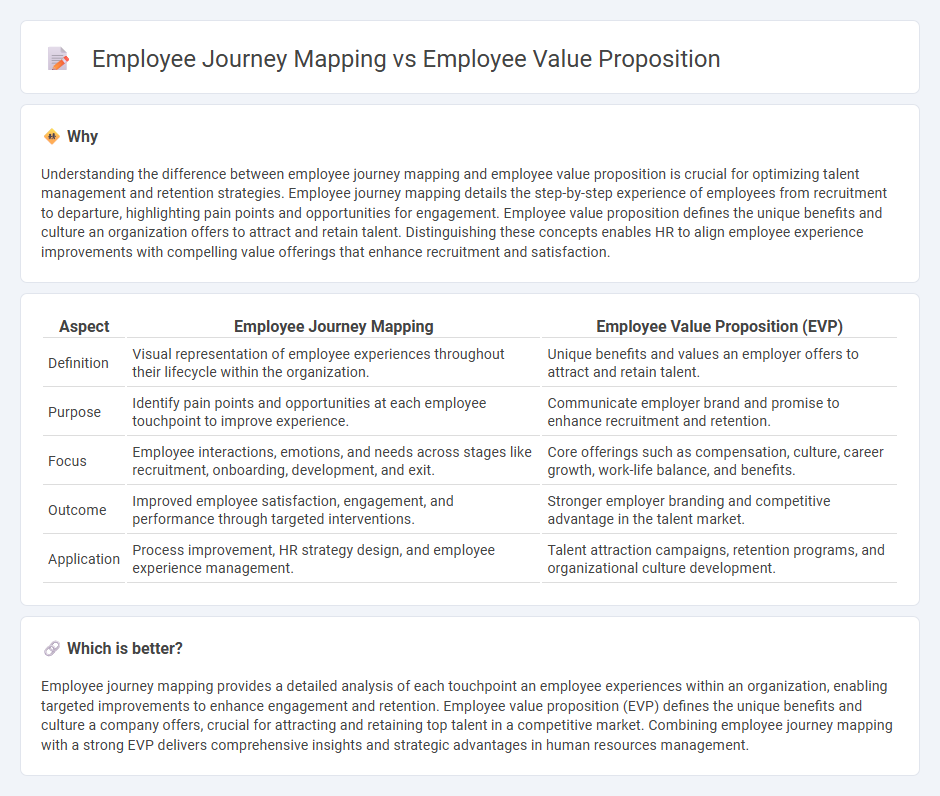
Employee journey mapping visualizes the entire experience an employee has within an organization, identifying key touchpoints that influence engagement and satisfaction. In contrast, the employee value proposition (EVP) defines the unique set of benefits and rewards an employer offers to attract and retain talent. Discover how aligning journey mapping with a compelling EVP can transform workforce dynamics.
Why it is important
Understanding the difference between employee journey mapping and employee value proposition is crucial for optimizing talent management and retention strategies. Employee journey mapping details the step-by-step experience of employees from recruitment to departure, highlighting pain points and opportunities for engagement. Employee value proposition defines the unique benefits and culture an organization offers to attract and retain talent. Distinguishing these concepts enables HR to align employee experience improvements with compelling value offerings that enhance recruitment and satisfaction.
Comparison Table
| Aspect | Employee Journey Mapping | Employee Value Proposition (EVP) |
|---|---|---|
| Definition | Visual representation of employee experiences throughout their lifecycle within the organization. | Unique benefits and values an employer offers to attract and retain talent. |
| Purpose | Identify pain points and opportunities at each employee touchpoint to improve experience. | Communicate employer brand and promise to enhance recruitment and retention. |
| Focus | Employee interactions, emotions, and needs across stages like recruitment, onboarding, development, and exit. | Core offerings such as compensation, culture, career growth, work-life balance, and benefits. |
| Outcome | Improved employee satisfaction, engagement, and performance through targeted interventions. | Stronger employer branding and competitive advantage in the talent market. |
| Application | Process improvement, HR strategy design, and employee experience management. | Talent attraction campaigns, retention programs, and organizational culture development. |
Which is better?
Employee journey mapping provides a detailed analysis of each touchpoint an employee experiences within an organization, enabling targeted improvements to enhance engagement and retention. Employee value proposition (EVP) defines the unique benefits and culture a company offers, crucial for attracting and retaining top talent in a competitive market. Combining employee journey mapping with a strong EVP delivers comprehensive insights and strategic advantages in human resources management.
Connection
Employee journey mapping identifies key touchpoints and experiences throughout the workforce lifecycle, directly informing the development of a compelling Employee Value Proposition (EVP). By analyzing employee interactions, organizations can tailor their EVP to address specific needs, motivations, and pain points, boosting engagement and retention. Integrating journey mapping insights into EVP strategies enhances alignment between company offerings and employee expectations.
Key Terms
**Employee Value Proposition:**
Employee Value Proposition (EVP) defines the unique set of benefits and rewards an organization offers to attract, engage, and retain employees, encompassing compensation, work culture, career development, and work-life balance. It directly influences talent acquisition and employee satisfaction by clearly communicating the employer's commitment to employee growth and well-being. Discover how crafting a compelling EVP can transform your workforce and organizational success.
Employer Branding
Employee Value Proposition (EVP) defines a company's unique offerings and culture that attract and retain talent, forming the foundation of strong employer branding. Employee Journey Mapping visualizes each touchpoint an employee experiences, enabling employers to enhance engagement and satisfaction throughout the employment lifecycle. Discover how aligning EVP with journey mapping elevates your employer brand and drives talent success.
Talent Attraction
Employee Value Proposition (EVP) defines the unique benefits and culture an organization offers to attract top talent, emphasizing compensation, career development, and workplace environment. Employee Journey Mapping outlines the candidate experience from application to onboarding, identifying touchpoints that influence talent attraction and retention strategies. Explore how aligning EVP with journey mapping enhances employer branding and optimizes talent attraction efforts.
Source and External Links
Employee Value Proposition (EVP): All You Need to Know in 2025 - An employee value proposition is the unique value an employer offers employees in return for their skills and commitment, including compensation, work-life balance, stability, location, and respect, which together shape how employees perceive and engage with the organization.
13 Inspiring Employee Value Proposition Examples That Work - An EVP is a combination of rewards and benefits given to employees for their work, comprising compensation, work-life balance, stability, location, and respect, and serves as an internal promise that drives recruitment, retention, and engagement.
Employee Value Proposition (EVP) : Definition and Guide - The EVP is a statement of the values, rewards, recognition, support, and company culture an employer offers to enable employees to do their best work, differentiate the company from competitors, and create a mutually beneficial employer-employee relationship.
 dowidth.com
dowidth.com